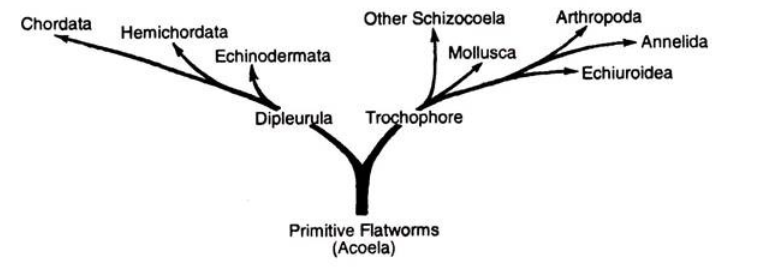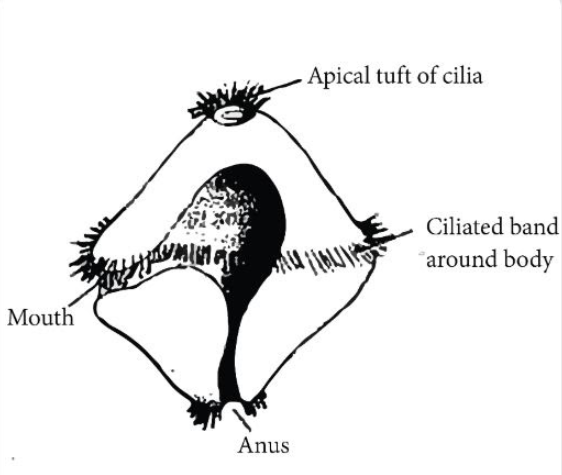
Answer
465.6k+ views
Hint: This plankton-like structure is a larval form that is characteristic of marine mollusks and marine annelids, echiurans, and sipunculans.
The above-drawn figure is of Trochophore larva.
Complete answer:
Trochophore larva has a prominent status in the evolutionary context. Studies are suggestive of the Trochophore larva as a bridge between radial and bilateral symmetry. The larval form shows similarities with many invertebrate groups.
Many studies claimed that the trochophore is an evident transitional stage in the line of the emergence of the bilateral groups (e.g., Rotifers) from the radial groups (Ctenophores). Similarities between the trochophore and the echinoderm larva (Bipinnaria and Pluteus) and Tornaria larva of Balanoglossus further enriched this fact.

Fig: Significance of trochophore larva
Characteristics of the larva: Trochophore larva is a free-swimming larva having a spherical or pear-shaped body. The anterior part of their body is broader than the posterior part. It possesses bilateral symmetry. The body consists of the mouth, alimentary canal, and anus. The mouth is located at the midventral line and it opens into the alimentary canal through the stomach. The canal ends at the anus. They possess a round wheel-shaped band of cilia that helps in movement and ingestion of food.
Note: 1. The term ‘trochophore' is derived from the Greek word ‘trokhos’ meaning ‘wheel' and ‘phero' meaning ‘to bear or to carry'.
2. In some trochophore larva, an additional ring of cilia can be present which is known as the telotroch.
3. Some of the trochophores bear Ocelli or eyespots that help in sensory reception.
4. The larva was first discovered by the Swedish naturalist Loven in 1840. So, it is sometimes also known as the ‘Loven’s larvae.
The above-drawn figure is of Trochophore larva.
Complete answer:
Trochophore larva has a prominent status in the evolutionary context. Studies are suggestive of the Trochophore larva as a bridge between radial and bilateral symmetry. The larval form shows similarities with many invertebrate groups.
Many studies claimed that the trochophore is an evident transitional stage in the line of the emergence of the bilateral groups (e.g., Rotifers) from the radial groups (Ctenophores). Similarities between the trochophore and the echinoderm larva (Bipinnaria and Pluteus) and Tornaria larva of Balanoglossus further enriched this fact.

Fig: Significance of trochophore larva
Characteristics of the larva: Trochophore larva is a free-swimming larva having a spherical or pear-shaped body. The anterior part of their body is broader than the posterior part. It possesses bilateral symmetry. The body consists of the mouth, alimentary canal, and anus. The mouth is located at the midventral line and it opens into the alimentary canal through the stomach. The canal ends at the anus. They possess a round wheel-shaped band of cilia that helps in movement and ingestion of food.
Note: 1. The term ‘trochophore' is derived from the Greek word ‘trokhos’ meaning ‘wheel' and ‘phero' meaning ‘to bear or to carry'.
2. In some trochophore larva, an additional ring of cilia can be present which is known as the telotroch.
3. Some of the trochophores bear Ocelli or eyespots that help in sensory reception.
4. The larva was first discovered by the Swedish naturalist Loven in 1840. So, it is sometimes also known as the ‘Loven’s larvae.
Recently Updated Pages
Who among the following was the religious guru of class 7 social science CBSE

what is the correct chronological order of the following class 10 social science CBSE

Which of the following was not the actual cause for class 10 social science CBSE

Which of the following statements is not correct A class 10 social science CBSE

Which of the following leaders was not present in the class 10 social science CBSE

Garampani Sanctuary is located at A Diphu Assam B Gangtok class 10 social science CBSE

Trending doubts
Which are the Top 10 Largest Countries of the World?

A rainbow has circular shape because A The earth is class 11 physics CBSE

Fill the blanks with the suitable prepositions 1 The class 9 english CBSE

How do you graph the function fx 4x class 9 maths CBSE

Give 10 examples for herbs , shrubs , climbers , creepers

In Indian rupees 1 trillion is equal to how many c class 8 maths CBSE

The Equation xxx + 2 is Satisfied when x is Equal to Class 10 Maths

Difference between Prokaryotic cell and Eukaryotic class 11 biology CBSE

What is BLO What is the full form of BLO class 8 social science CBSE





